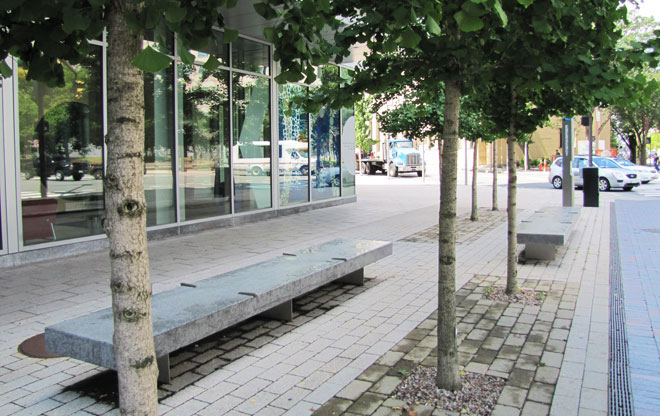
September 25, 2013
The Landscape Architect’s Guide to Boston
As cities become nature-friendly, green spaces sprout everywhere
Why is Boston one of the best cities to live in? Why is it also one of the most sustainable cities in North America? We argue it’s because of this city’s legacy of great parks and open spaces. To enable visitors and locals alike to truly understand this, the American Society of Landscape Architects (ASLA) has created the Landscape Architect’s Guide to Boston.
The guide, which has both a web and mobile version, features tours of 100 historic and contemporary landscapes across Boston, Cambridge, and Brookline created by 28 local landscape architects. We highlight the landscapes accessible via public transit, so we didn’t include all sites. We sought to include a representative collection across many neighborhoods. The guide is divided into 26 distinct tours, which each include a printable walking or biking map for easy exploration.
With a click of their computer or tap of their smartphones, visitors and locals alike can now deepen their knowledge of landscape architecture through expert commentary and more than 1,100 images.
Boston has long been a trendsetter when it comes to urban design and sustainability. Indeed, the city ranks in the top 10 nationally for sustainability, park space, and quality of life, in large part because its designed landscapes are integral to its urban fabric.
Its landscape architects have played a crucial role in making the city a better place to live, starting in the late 19th century, when Frederick Law Olmsted designed the Emerald Necklace, to today’s generation of practitioners who are creating waterfront parks and beloved green spaces.
So the guide highlights historic parks created by Olmsted and other early innovators, like the Back Bay Fens and The Riverway, which are some of the first examples of green infrastructure. As Marion Pressley, FASLA, Pressley Associates, explains in the tour, Olmsted created these sites to not only deal with sanitation and stormwater, but also provide a respite from urban living. This was early multi-functional infrastructure. It’s still an influential model for landscape architects everywhere.

Back Bay Fens.
Courtesy Alex Maclean / Landslides

The Riverway.
Courtesy Marion Pressley, FASLA, Pressley Associates
Also featured in the guide are new sustainable works that demonstrate cutting-edge landscape technologies — including Raymond V. Mellone Park, a park that also manages storm water, and Condor Street Urban Wild, which caps toxic soils to create a new wildlife habitat and urban oasis.

Raymond V. Mallone Park.
Courtesy Michael Van Valkenburgh Associates

Condor Street Urban Wild.
Courtesy Kaki Martin, ASLA, Klopfer Martin Design Group
Major landscape projects show why Boston is one of the great re-developers of its urban core. In his tour, JP Shadley, FASLA, Shadley Associates, argues the Rose F. Kennedy Greenway, part of the “Big Dig” project that got so much negative press at the time, is a huge success; it shows that large-scale urban redevelopment can really work. What was once a highway cutting its way through downtown Boston is now a rich, diverse, miles-long linear park used by thousands every day, dramatically improving the quality of life for people living and working there.

Chinatown Park. Rose F. Kennedy Greenway.
Courtesy Carol R. Johnson Associates
Cynthia Smith, FASLA, and Bob Uhlig, ASLA, at Halvorson Design Partnership show how the New Charles River Basin totally transformed the Charles River’s industrial past into an inter-connected set of parks, with amazing underpass parks amid the web of infrastructure.

Paul Revere Park.
Courtesy Carol R. Johnson Associates
Boston’s great universities are highlighted as well. A tour of Harvard University’s campus by Laura Solano, ASLA, a principal at Michael Van Valkenburgh Associates, takes us to The Plaza, a brand-new public space designed by Stoss Landscape Urbanism to facilitate social interactions, as well as the calming Tanner Fountain, designed by Peter Walker, FASLA, which is a contemporary icon of landscape design.

The Plaza at Harvard University.
Courtesy Stoss Landscape Urbanism

Tanner Fountain.
Courtesy Alan Ward, FASLA
And at MIT, we now understand the simple elegance of Reed Hilderbrand’s North Court and Main Street and the incredible value of that campuses’ rich public art collection, thanks to a tour by Laura Tenny, ASLA, a landscape architect working at MIT.

North Court and Main Street, MIT.
Courtesy Laura Tenny, ASLA

Henry Moore’s Three-Piece Reclining Figure Draped (1976) at Killian Court. MIT Public Art Collection.
Courtesy Laura Tenny, ASLA
This is really just the tip of the iceberg. There are more than a thousand images in the web site.
The guide works as an educational tool in what landscape architects contribute to the built environment, as well as how nature and structures can live in harmony. “Boston’s vibrant public realm didn’t just magically appear,” adds ASLA president Tom Tavella, “but was carefully designed over the years, and is continually evolving, through interactions among elected leaders, communities, and landscape architects.”
Jared Green is a prolific writer on landscape architecture at Dirt, the newsletter of the American Society of Landscape Architects.





